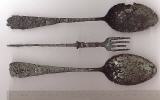Modern (Post 1500) Iron
Blunt Crossbow Bolt
This type of crossbow bolt was used to kill or knock unconscious the game without damaging the fur or feathers. Remains of tin gilt to prevent corrosion are still visible.
Winged Hunting Crossbow Bolt
15-17. century. Winged crossbow bolts were used for hunting as they caused maximum tissue damage. This type is found less often than the standard type featuring a square or rhombic cross section. The socket is made from a copper alloy. Since the copper kills the micro organisms responsible for decay the wood in the socket is still intact after several centuries.
Cleaned State
The cleaned version shows how much the iron was attacked by corrosion – in contrast to the copper alloy socket.
Peasants knifes AD 1400 - 1600
In medieval times the common people were not allowed to carry swords. But they were allowed to carry knifes even very large ones. These so-called Peasant’s knifes were the all-purpose tool and weapon of the common people. Typically, they are 30-50 cm long though longer specimens have been found.
Peasant Knife # 1 Find State.
The curved form is unusual.
Peasant Knife # 1 Cleaned State
Peasant Knife #2 Cleaned State
Peasant Knife # 3 Find State and Cleaned State
Peasant Knife # 4 Find State
The heavy and well preserved knife is some 20”/52 cm long. The hand guard – the oblong structure – is still visible.
Peasant Knife # 4 and Finder
Rafter"s hook 1400 - 1800
The item was hidden behind a large rock at the bank of a large river. From medieval times into the 19. century logs were floated downstream on that river..
Spurs
The most common finds related to horses are horse shoes. Spurs are much less often found.. The most rare finds are bits and stirrups – maybe because the rider noticed the loss immediately.
Spur # 1
Spur # 2
For the full search story, see votive painting reveals Napoleon metal detecting site .
Spur #3
Spur #4
Strike a light
These items were struck against a piece of flint stone to create some sparkles to light a fire.
Belt Hook 30 Year War
Horseshoe Group 1500-1850
Early modern horse shoes are common in forests and, especially, at former waterholes. The animals lost their irons in the muddy ground and without a metal detector there was not way to get them back. These finds help to trace old roads - and make nice “good luck” gifts for friends when cleaned.
Key 18. century
Cutlery 18./19. century
(C) Thorsten Straub www.metal-detecting.de 2006-2019.















